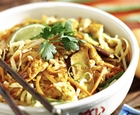|
Thai Entree Stir-Fried Noodles One of the most popular dishes in Thailand, Pad Thai's popularity is moving to the US.
This dish cooks quickly, so make sure everything is prepared ahead of time. You don’t want the Pad Thai to overcook while you make the sauce or chop nuts. Tamarind sauce: in a saucepan combine tamarind paste with 1/4 C warm water. Add sugar and shrimp paste. Heat to melt and blend the ingredients. Begin adding chili pepper powder. Add 1/2 tsp. chili powder (or more according to your taste). Set the sauce aside. Prep: soak noodles in warm water 40-60 min. till malleable but not too tender. Drain well. Stir-Fry: Heat oil in wok or large skillet till almost smoking. Add chicken and stir-fry quickly for 1 minute. Add tofu and garlic, stirring for 2 more minutes. Add tamarind sauce, bit at a time, stirring and blending ingredients. Next add shrimp, stirring 1 minute. Keep adding sauce. Move everything over to side and add eggs, letting them cook for 30 seconds; then toss eggs together with mixture. Add drained noodles to skillet or wok. Add more sauce, stirring to blend. Add sprouts, 1/2 the peanuts, stirring all the time. If it’s too dry, add more sauce, oil, or even a bit of water. Cook till noodles are slightly al dente. Serve: turn Pad Thai into a serving dish, top with remaining peanuts, scallions, cilantro, and lime quarters. Serve immediately. * Thin rice noodles make it difficult to cook this in large batches. So for more than four people, don't double the recipe—instead, cook two separate batches.
|
Tips & Glossary Southeast Asian cuisine seeks a balance of hot, sour, sweet, and salty—all in a single dish. Adjust to suit your taste perferences. Fish Sauce: a liquid made of fermented anchovies and bottled (like soy sauce). Galanga: a root related to ginger though with deeper tones of citrus and pine. Tough to slice...use a sharp knife. (If galanga is not to be found, use ginger root.) Lemon Grass: tall, stalky, critus-flavored grass. Prior to cooking, pound or crush gently to release flavor. Rice Sticks: aka rice noodles or vermicelli; thin dried noodles from rice flour. Soak before using, about 1 hour, or less, (depending on how soft or chewy you like your noodles.) Shrimp Paste: fermented, ground shrimp. It carries a pungent aroma but is essential in cooking. Tamarind: tropical tree grown in Africa and Asia; its fruit pulp is used as souring agent. It’s also found in Worcestershire sauce and some ketchup. |

